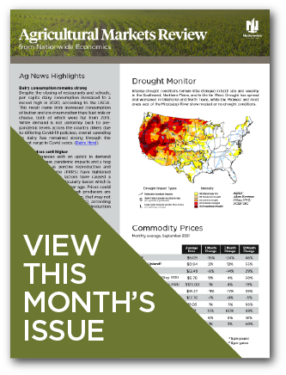H-2A job certifications climb to a record high
Low water levels threaten grain transportation
Even prior to the current longstanding crunch in the labor market, farms were having difficulty recruiting domestic workers for farm work. This resulted in farms increasingly turning to the H-2A visa program to get international workers to meet agricultural labor demand. Not surprisingly, as the unemployment rate fell eventually to historically low levels over the course of 2022 and 2023, use of the H-2A program surged. The latest numbers from the Department of Labor indicate that demand for H-2A workers continued to climb in fiscal year (FY) 2023 — albeit at a slower pace — to a record high. Details from the latest data can be found below.

- Following growth in DOL-certified H-2A positions of 15 percent and 17 percent in 2021 and 2022, respectively, growth cooled significantly in 2023, falling to two percent. Still, the increase in 2023 was enough to set a record high for certified H-2A positions.
- Total certified positions came to 378,513 in 2023, which was over 100,000 more than in 2020 (prior to the current labor market tightening). Growth in that three-year period came to 27 percent.
- Highlighting demand for workers from farms, growth in the program has occurred despite large gains in the Adverse Effect Wage Rate (AEWR, or the minimum wage employers participating in the program are required to pay). Since 2020, the AEWR has climbed nearly 19 percent from $13.99 in 2020 to $16.62 in 2023. The start of fiscal year 2024 saw another bump in the AEWR of 5.6 percent, bringing the national average AEWR to $17.55 – a record high.
- All 50 states (and Puerto Rico) had H-2A positions granted, but much of the program’s usage in 2023 came from only a handful of states. Over half of certified positions came from states in the top five for program utilization. Those states are:
- Florida (51,987)
- California (40,758)
- Georgia (37,536)
- Washington (35,680)
- North Carolina (26,146)
- By comparison, 10 states had fewer than 1,000 certified H-2A positions, including Rhode Island, which only had 10.
(AFBF)
Ag News Highlights
Sierra Nevada snowpack off to a slow start
The current snowpack at Donner Summit is currently at 37 percent of its historical average – a slow start to an important part of the year for the Central Sierra Nevada. Still, there is precedent for a turnaround, notes Andrew Schwartz, lead scientist at UC Berkeley Central Sierra Snow Lab. “Even though we’re starting off in kind of a slow, and maybe a little bit of a precarious, spot with our snowpack, that doesn’t necessarily mean it’ll stay that way,” said Schwartz in an interview while recalling that the winter of 2016-2017 started similarly slow before rebounding into one of the best winters for snowpack in recent memory.
Schwartz pointed out that snowpack is an important store of water for the region in the spring and summer months because, unlike rainfall which is stored and managed via reservoirs, snowpack is self-managed.
Beef prices, like those of all meats, are high
A confluence of factors led to record beef prices in 2023, but that hasn’t prevented consumers from buying beef. This could be a story of inelastic demand for beef, which would be good news for cattle ranchers, but it could also be that beef isn’t yet considered expensive relative to its substitutes. Despite making headlines in the back half of the year, beef inflation was only playing catch-up to other proteins. Looking beyond the 12-month inflation rate and going back to pre-Covid, prices for pork chops, chicken, and eggs have climbed 27 percent, 45 percent, and 50 percent, respectively. By comparison, beef prices over that same period have risen 30 percent, and food prices overall are up 25 percent. (Marketplace)
Corn and soybean prices fall due to high yields
The December World Agriculture Supply and Demand Estimates (WASDE) surprised traders with substantial increases in production for corn and soybeans due to higher-than-expected yields. Consequently, the price of both commodities fell sharply the week of January 8. It’s also worth noting that the same seed genetics which produced strong yields in the U.S. despite plenty of dry weather have been used in Brazil — a country seeing estimated production cut due to severe droughts. (Ag Web)
Citations/Disclaimers
-
The information in this report is provided by Nationwide Economics and is general in nature and not intended as investment or economic advice, or a recommendation to buy or sell any security or adopt any investment strategy. Additionally, it does not take into account any specific investment objectives, tax and financial condition or particular needs of any specific person.
The economic and market forecasts reflect our opinion as of the date of this report and are subject to change without notice. These forecasts show a broad range of possible outcomes. Because they are subject to high levels of uncertainty, they will not reflect actual performance. We obtained certain information from sources deemed reliable, but we do not guarantee its accuracy, completeness or fairness.


